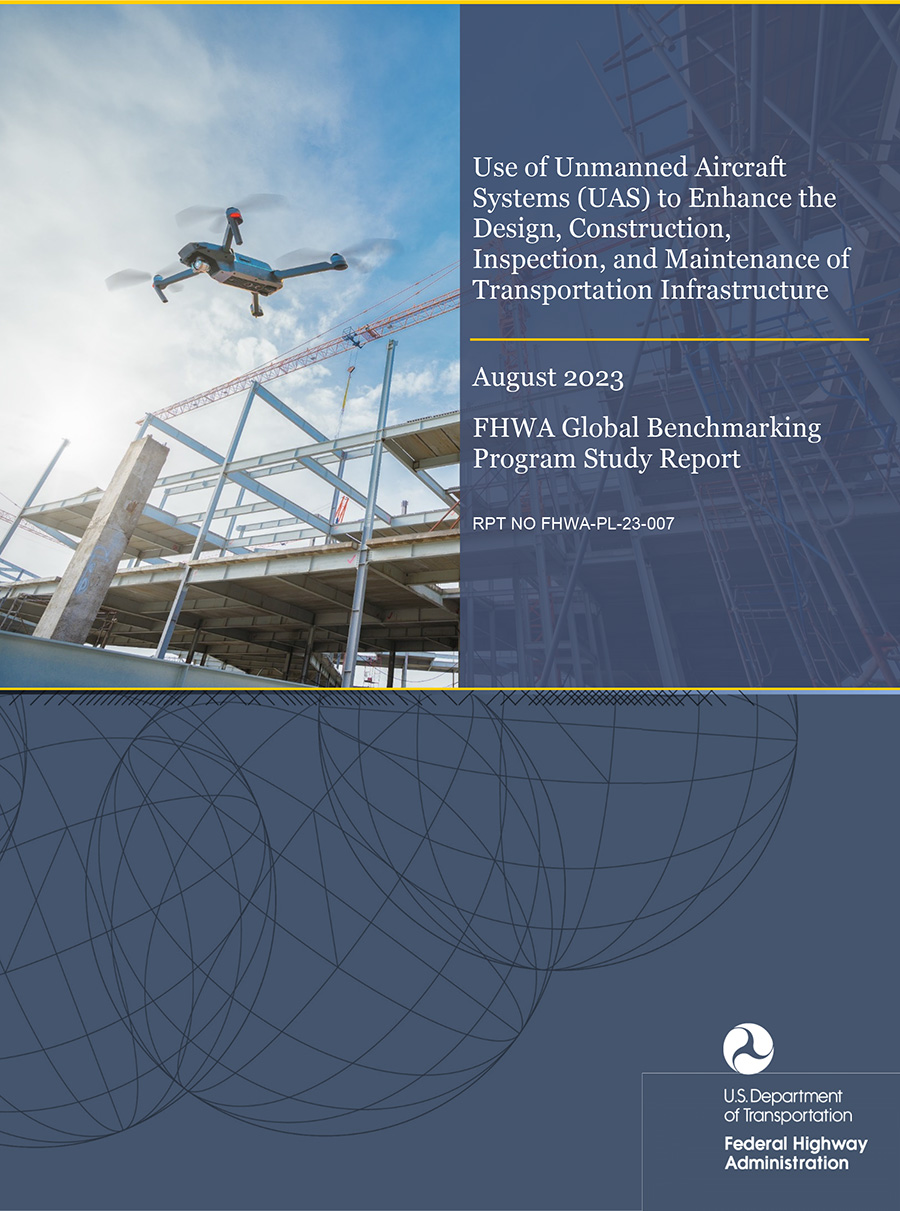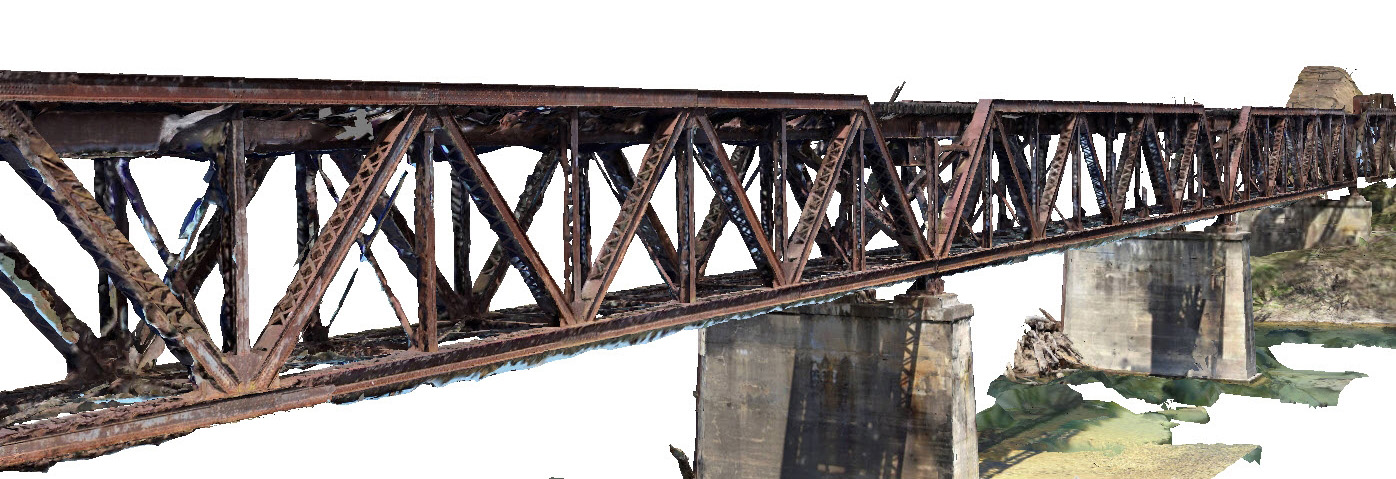
Unlocking UAS Data: Strategies for Effective Management and Collaboration
Over the past decade, agencies across the United States and in other countries have increased their use of unmanned aerial systems (UAS) for a variety of applications in their infrastructure programs. UAS provide agencies with a safe, inexpensive means to collect tremendous amounts of data via onboard cameras, video, sensors, and other tools. The current challenge is how to collect the right type of data and use it effectively.

FHWA’s latest Global Benchmarking Program Study documents UAS data standardization practices in Germany and the United Kingdom.
Credit: FHWAIn 2019, FHWA initiated a Global Benchmarking Program (GBP) study that documented UAS data management approaches in Germany and the United Kingdom (U.K.) that could be implemented by U.S. agencies.
James Gray, FHWA Construction Technology Program Manager and GBP study team lead, said the study team started with a domestic review to identify the major challenges in this country for advancing UAS. “Data management emerged as probably one of the biggest needs going forward,” said Gray. “What we learned is that we’ve become very good at collecting data, but what’s needed are plans for how to manage the data so it provides actionable information we can use to meet actual business needs in the transportation sector.”
Data Management and Digital Models
As agencies move toward using UAS-collected data to automate processes and create efficient workflows, data standards are providing the common language needed for sharing and collaboration.
As part of an effort to standardize data sharing, National Highways (NH), a government-owned company in the U.K., created a Digital Product Catalogue (DPC). The DPC is used for storing, managing, and sharing digital models of small individual construction products up to large structures. Construction suppliers can download blank data sheets with standardized attribute fields, fill the sheet with attributes of the item being delivered, and submit the sheet to NH reviewers to upload to the DPC.
German agencies are creating datasets of annotated images showing structural defects such as cracks, spalling, corrosion, and vegetation growth. They are using the datasets to train machine learning/artificial intelligence (ML/AI) algorithms to automatically detect structural defects post-inspection, which will allow users to focus their attention on high-risk or unusual issues.
Combining digital models with ML/AI algorithms offers the opportunity to detect changes among models of the same construction asset created at different times. Identifying defects early enables preventative maintenance that results in safety improvements, cost savings, and time savings.
Asset Lifecycle Management
NH has employed a Rapid Engineering Model (REM) platform that integrates engineering standards, as well as topographic and environmental data from inspection and survey tools such as UAS, with a digital model of a construction site, project, or environment for lifecycle management. For existing projects, REM displays an annotated construction environment showing potential safety hazards, whether individual construction elements meet design standards, and visualizations of proposed or planned modifications. For new projects, REM has accelerated routine design at project start and reduced overall design time and cost by up to 80 percent.
German agencies have also developed a framework for systematic data generation and processing to support scaling UAS operations for the construction lifecycle. The framework includes the visualization of UAS flight trajectories and optimization to meet the data quantity, data quality, digital model resolution, and other inspection requirements for structures.
“From preliminary design all the way to operations and maintenance, the key thread in these examples from the U.K. and Germany is the use of a common data standard,” said Gray. “Having a common standard will allow agencies to generate consistent, repeatable, standardized datasets that yield benefits throughout the assets’ lifecycle.”

Example of a 3D model of a bridge produced using photogrammetry data from a UAS.
Credit: FHWA Western Federal Lands Highway DivisionSafety and Operations Improvements
The GBP study also highlighted the safety and operational benefits German and U.K. agencies are realizing from their UAS programs.
NH is evaluating a new practice for confined space bridge inspections using small UAS. In this case, only the remote pilot-in-command, visual observer, and support engineers (who do not need to be UAS remote pilots) are required onsite. The bridge inspector can evaluate photos and video onsite or remotely. This practice reduces risk by using fewer personnel (traditionally four inspectors entering the bridge deck plus four rescue crew) and reduces the required time from a few days to hours.
In Germany, the Port of Hamburg is employing remote UAS operations with a “drone-in-a-box” docking system complete with shelter, box beacon, landing pad, and battery charging. The UAS launches autonomously from its box, and the box receives and transmits data with the port’s UAS Integrated Command Center. In addition to reducing safety risk to workers performing inspections, the port reported that the UAS docking system resulted in 60-percent cost savings and 70-percent time savings for inspecting port infrastructure, gantry cranes, and shipping containers.
Two of the States involved in the GBP study, California and North Carolina, are already adopting some of these proven practices from the U.K. and Germany. Both the North Carolina Department of Transportation (DOT) and California DOT plan to pilot the UAS docking technology. In addition, the California DOT will use a 2023 FHWA Advanced Digital Construction Management Systems grant to develop its own Digital Products Catalog, using the NH system as a model.
—MORE INFORMATION
Read the GBP study report on use of UAS to enhance transportation infrastructure.
Listen to an FHWA webinar on the GBP study with presenters from Germany and the United Kingdom (Passcode: 1sosBA?=).
Visit the FHWA UAS website for links to more resources.
Contact James Gray, FHWA Office of Infrastructure, for additional details.
Disclaimer: The U.S. Government does not endorse products or manufacturers. Trademarks or manufacturers’ names appear in this document only because they are considered essential to the objective of the document. They are included for informational purposes only and are not intended to reflect a preference, approval, or endorsement of any one product or entity.
Except for the statutes and regulations cited, the contents of this document do not have the force and effect of law and are not meant to bind the States or the public in any way. This document is intended only to provide information regarding existing requirements under the law or agency policies.
Recommended Citation: U.S. Department of Transportation, Federal Highway Administration - Washington, DC (2024) Innovator Newsletter, May/June 2024, Volume 17 (102). https://doi.org/10.21949/1521779
- Cover
- New Opportunities for Building Bridges Better: The Evolution of UHPC
- Reconnecting Communities and Neighborhoods
- Brighter is Not Better: Emergency Vehicle Lighting Gets “Smart”
- Unlocking UAS Data: Strategies for Effective Management and Collaboration
- States Innovate
- EDC Outtakes: Next-Generation TIM
- About Innovator


